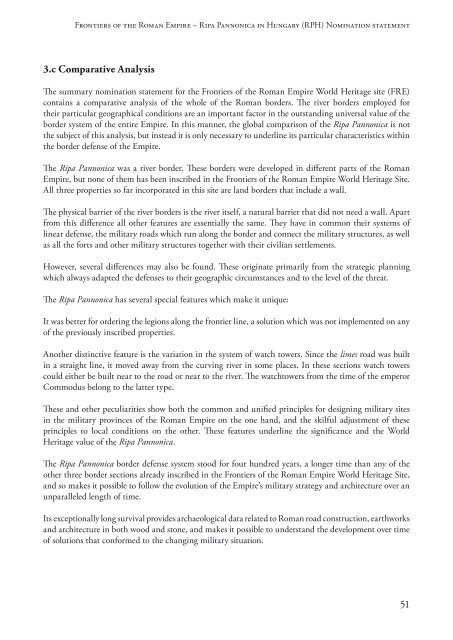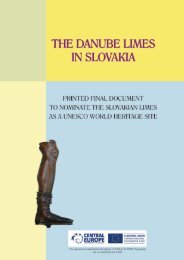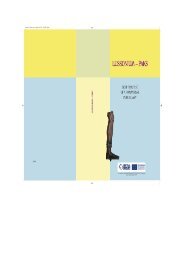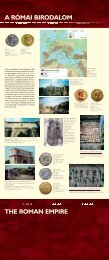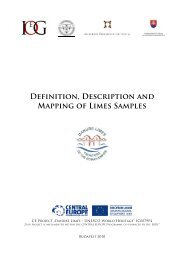the PDF version! - Danube Limes
the PDF version! - Danube Limes
the PDF version! - Danube Limes
You also want an ePaper? Increase the reach of your titles
YUMPU automatically turns print PDFs into web optimized ePapers that Google loves.
Frontiers of <strong>the</strong> Roman Empire – Ripa Pannonica in Hungary (RPH) Nomination statement<br />
3.c Comparative Analysis<br />
The summary nomination statement for <strong>the</strong> Frontiers of <strong>the</strong> Roman Empire World Heritage site (FRE)<br />
contains a comparative analysis of <strong>the</strong> whole of <strong>the</strong> Roman borders. The river borders employed for<br />
<strong>the</strong>ir particular geographical conditions are an important factor in <strong>the</strong> outstanding universal value of <strong>the</strong><br />
border system of <strong>the</strong> entire Empire. In this manner, <strong>the</strong> global comparison of <strong>the</strong> Ripa Pannonica is not<br />
<strong>the</strong> subject of this analysis, but instead it is only necessary to underline its particular characteristics within<br />
<strong>the</strong> border defense of <strong>the</strong> Empire.<br />
The Ripa Pannonica was a river border. These borders were developed in different parts of <strong>the</strong> Roman<br />
Empire, but none of <strong>the</strong>m has been inscribed in <strong>the</strong> Frontiers of <strong>the</strong> Roman Empire World Heritage Site.<br />
All three properties so far incorporated in this site are land borders that include a wall.<br />
The physical barrier of <strong>the</strong> river borders is <strong>the</strong> river itself, a natural barrier that did not need a wall. Apart<br />
from this difference all o<strong>the</strong>r features are essentially <strong>the</strong> same. They have in common <strong>the</strong>ir systems of<br />
linear defense, <strong>the</strong> military roads which run along <strong>the</strong> border and connect <strong>the</strong> military structures, as well<br />
as all <strong>the</strong> forts and o<strong>the</strong>r military structures toge<strong>the</strong>r with <strong>the</strong>ir civilian settlements.<br />
However, several differences may also be found. These originate primarily from <strong>the</strong> strategic planning<br />
which always adapted <strong>the</strong> defenses to <strong>the</strong>ir geographic circumstances and to <strong>the</strong> level of <strong>the</strong> threat.<br />
The Ripa Pannonica has several special features which make it unique:<br />
It was better for ordering <strong>the</strong> legions along <strong>the</strong> frontier line, a solution which was not implemented on any<br />
of <strong>the</strong> previously inscribed properties.<br />
Ano<strong>the</strong>r distinctive feature is <strong>the</strong> variation in <strong>the</strong> system of watch towers. Since <strong>the</strong> limes road was built<br />
in a straight line, it moved away from <strong>the</strong> curving river in some places. In <strong>the</strong>se sections watch towers<br />
could ei<strong>the</strong>r be built near to <strong>the</strong> road or near to <strong>the</strong> river. The watchtowers from <strong>the</strong> time of <strong>the</strong> emperor<br />
Commodus belong to <strong>the</strong> latter type.<br />
These and o<strong>the</strong>r peculiarities show both <strong>the</strong> common and unified principles for designing military sites<br />
in <strong>the</strong> military provinces of <strong>the</strong> Roman Empire on <strong>the</strong> one hand, and <strong>the</strong> skilful adjustment of <strong>the</strong>se<br />
principles to local conditions on <strong>the</strong> o<strong>the</strong>r. These features underline <strong>the</strong> significance and <strong>the</strong> World<br />
Heritage value of <strong>the</strong> Ripa Pannonica.<br />
The Ripa Pannonica border defense system stood for four hundred years, a longer time than any of <strong>the</strong><br />
o<strong>the</strong>r three border sections already inscribed in <strong>the</strong> Frontiers of <strong>the</strong> Roman Empire World Heritage Site,<br />
and so makes it possible to follow <strong>the</strong> evolution of <strong>the</strong> Empire’s military strategy and architecture over an<br />
unparalleled length of time.<br />
Its exceptionally long survival provides archaeological data related to Roman road construction, earthworks<br />
and architecture in both wood and stone, and makes it possible to understand <strong>the</strong> development over time<br />
of solutions that conformed to <strong>the</strong> changing military situation.<br />
51


